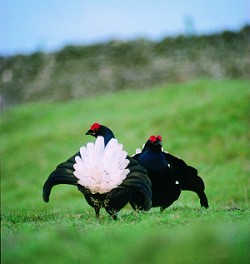3rd May 2012
 The encouraging results of the population survey carried out by The Game & Wildlife Conservation Trust follows two successive breeding years when the weather has been much kinder to the charismatic wild birds. Numbers fell to below 500 males in 2010 when the northern uplands were hit by the worst winter weather conditions for almost 30 years. 95% of remaining black grouse – a‘red listed’ species – are found on the fringe areas of English red grouse moors thanks to the positive management actions of grouse moor owners.
The encouraging results of the population survey carried out by The Game & Wildlife Conservation Trust follows two successive breeding years when the weather has been much kinder to the charismatic wild birds. Numbers fell to below 500 males in 2010 when the northern uplands were hit by the worst winter weather conditions for almost 30 years. 95% of remaining black grouse – a‘red listed’ species – are found on the fringe areas of English red grouse moors thanks to the positive management actions of grouse moor owners.
Once common in every English county, this year’s increase in population means that after an absence of 20 years 8 surplus male black grouse have been translocated to one of their former haunts in the Yorkshire Dales. The location, which is being kept secret to give the birds the best start, is the most southerly population of the scarce bird in Yorkshire.
Extending the range of Black Grouse beyond its restricted areas on the fringes of red grouse moors in Northumberland, County Durham, Cumbria and North Yorkshire has been a core aim for the bird’s recovery. However, until now, the recent weather-induced downward spiral in the population meant there were no spare males to move to new areas. The male birds – or Black Cock – need human intervention to physically transport them to new suitable areas as they will not stray more than 1km from their place of birth.
The Moorland Association landowner of the new site has carried out extensive native tree planting and predator control on the moorland fringe habitat. He also manages the open heather moorland using traditional techniques to encourage red grouse, providing the right mix of habitats in preparation for the Black Grouse’s arrival. Female birds, (grey hens), have already been seen in the area and the males have started their evocative mating display known as lekking.
Black grouse of high conservation concern have suffered steady declines and range contractions over the past 40 years, with the national population falling from an estimated 25,000 displaying males in 1970 to just over 5,000 in 2005.








